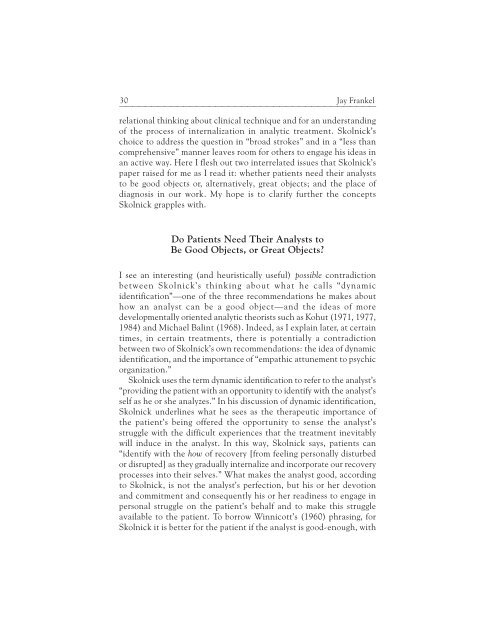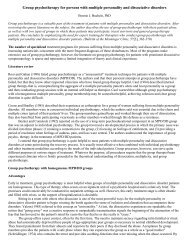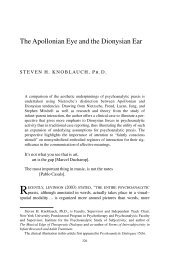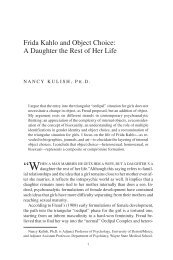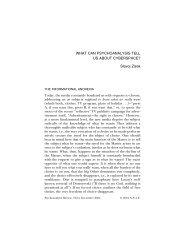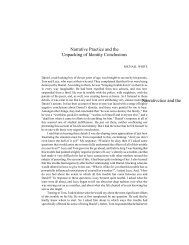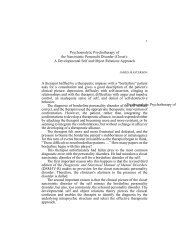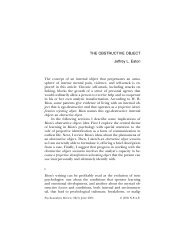What's a Good Object to Do? - PsyBC
What's a Good Object to Do? - PsyBC
What's a Good Object to Do? - PsyBC
You also want an ePaper? Increase the reach of your titles
YUMPU automatically turns print PDFs into web optimized ePapers that Google loves.
30 Jay Frankel<br />
⎯⎯⎯⎯⎯⎯⎯⎯⎯⎯⎯⎯⎯⎯⎯⎯⎯⎯⎯⎯⎯⎯⎯⎯⎯⎯⎯⎯⎯⎯⎯⎯⎯⎯⎯⎯⎯⎯⎯⎯<br />
relational thinking about clinical technique and for an understanding<br />
of the process of internalization in analytic treatment. Skolnick’s<br />
choice <strong>to</strong> address the question in “broad strokes” and in a “less than<br />
comprehensive” manner leaves room for others <strong>to</strong> engage his ideas in<br />
an active way. Here I flesh out two interrelated issues that Skolnick’s<br />
paper raised for me as I read it: whether patients need their analysts<br />
<strong>to</strong> be good objects or, alternatively, great objects; and the place of<br />
diagnosis in our work. My hope is <strong>to</strong> clarify further the concepts<br />
Skolnick grapples with.<br />
<strong>Do</strong> Patients Need Their Analysts <strong>to</strong><br />
Be <strong>Good</strong> <strong>Object</strong>s, or Great <strong>Object</strong>s<br />
I see an interesting (and heuristically useful) possible contradiction<br />
between Skolnick’s thinking about what he calls “dynamic<br />
identification”—one of the three recommendations he makes about<br />
how an analyst can be a good object—and the ideas of more<br />
developmentally oriented analytic theorists such as Kohut (1971, 1977,<br />
1984) and Michael Balint (1968). Indeed, as I explain later, at certain<br />
times, in certain treatments, there is potentially a contradiction<br />
between two of Skolnick’s own recommendations: the idea of dynamic<br />
identification, and the importance of “empathic attunement <strong>to</strong> psychic<br />
organization.”<br />
Skolnick uses the term dynamic identification <strong>to</strong> refer <strong>to</strong> the analyst’s<br />
“providing the patient with an opportunity <strong>to</strong> identify with the analyst’s<br />
self as he or she analyzes.” In his discussion of dynamic identification,<br />
Skolnick underlines what he sees as the therapeutic importance of<br />
the patient’s being offered the opportunity <strong>to</strong> sense the analyst’s<br />
struggle with the difficult experiences that the treatment inevitably<br />
will induce in the analyst. In this way, Skolnick says, patients can<br />
“identify with the how of recovery [from feeling personally disturbed<br />
or disrupted] as they gradually internalize and incorporate our recovery<br />
processes in<strong>to</strong> their selves.” What makes the analyst good, according<br />
<strong>to</strong> Skolnick, is not the analyst’s perfection, but his or her devotion<br />
and commitment and consequently his or her readiness <strong>to</strong> engage in<br />
personal struggle on the patient’s behalf and <strong>to</strong> make this struggle<br />
available <strong>to</strong> the patient. To borrow Winnicott’s (1960) phrasing, for<br />
Skolnick it is better for the patient if the analyst is good-enough, with


